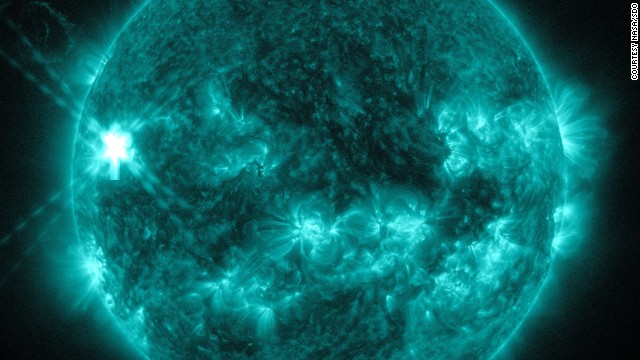 A mid-level flare erupted on the left side of the sun on July 8, 2014. This image from NASA's Solar Dynamics Observatory highlights the high-temperature solar material in a flare, which is typically colorized in teal.
A mid-level flare erupted on the left side of the sun on July 8, 2014. This image from NASA's Solar Dynamics Observatory highlights the high-temperature solar material in a flare, which is typically colorized in teal. 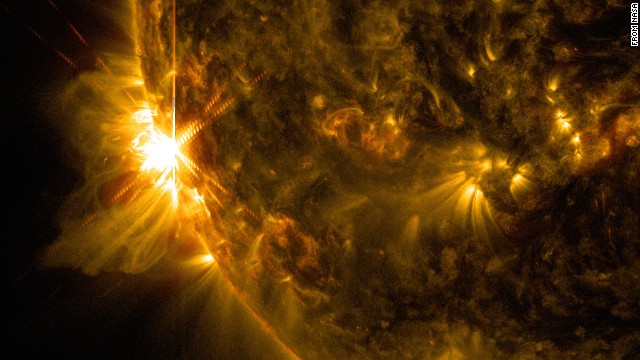 NASA's Solar Dynamics Observatory (SDO), which observes the sun 24 hours a day, captured this image of a solar flare on June 10.
NASA's Solar Dynamics Observatory (SDO), which observes the sun 24 hours a day, captured this image of a solar flare on June 10.  NASA captured this second flare, which appears as a bright flash on the left side of the sun, June 10.
NASA captured this second flare, which appears as a bright flash on the left side of the sun, June 10.  A coronal hole, almost square in its shape, is one of the most noticeable features on the sun on May 5-7, 2014. A coronal hole is an area where high-speed solar wind streams into space. It appears dark in extreme ultraviolet light as there is less material to emit in these wavelengths. Inside the coronal hole you can see bright loops where the hot plasma outlines little pieces of the solar magnetic field sticking above the surface. Because it is positioned so far south on the sun, there is less chance that the solar wind stream will impact us here on Earth.
A coronal hole, almost square in its shape, is one of the most noticeable features on the sun on May 5-7, 2014. A coronal hole is an area where high-speed solar wind streams into space. It appears dark in extreme ultraviolet light as there is less material to emit in these wavelengths. Inside the coronal hole you can see bright loops where the hot plasma outlines little pieces of the solar magnetic field sticking above the surface. Because it is positioned so far south on the sun, there is less chance that the solar wind stream will impact us here on Earth. 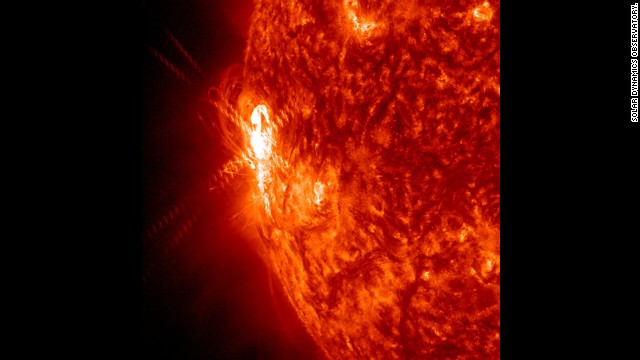 A large active region is giving off warning signs that this could be the source of powerful solar storms. It has already shot off two smaller flares (Jan. 2, 2014) as shown here in a wavelength of extreme ultraviolet light.
A large active region is giving off warning signs that this could be the source of powerful solar storms. It has already shot off two smaller flares (Jan. 2, 2014) as shown here in a wavelength of extreme ultraviolet light.  This image from the Solar Dynamics Observatory shows the sun on July 12, 2012 during an X1.4 class flare. The image is captured in the 304 Angstrom wavelength, which is typically colorized in red.
This image from the Solar Dynamics Observatory shows the sun on July 12, 2012 during an X1.4 class flare. The image is captured in the 304 Angstrom wavelength, which is typically colorized in red.  This image combines two sets of observations of the sun on July 12, 2012 from the SDO to give an impression of what the sun looked like shortly before it unleashed an X-class flare.
This image combines two sets of observations of the sun on July 12, 2012 from the SDO to give an impression of what the sun looked like shortly before it unleashed an X-class flare. 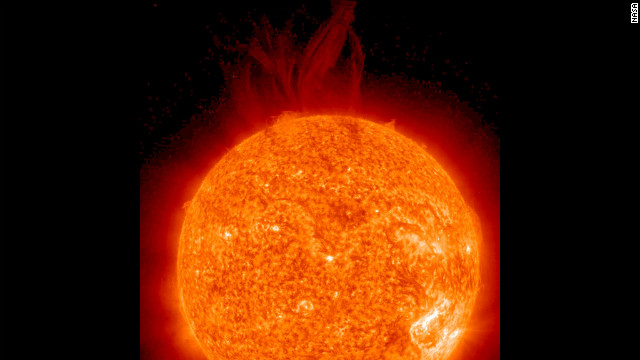 A very large filament became unstable and erupted June 27, 2012 as seen by the STEREO Ahead spacecraft in a wavelength of extreme UV light.
A very large filament became unstable and erupted June 27, 2012 as seen by the STEREO Ahead spacecraft in a wavelength of extreme UV light.  Active Region 1514 just could not contain itself as it popped off over a dozen flashes, minor eruptions, and flares over almost two days June 27-29, 2012.
Active Region 1514 just could not contain itself as it popped off over a dozen flashes, minor eruptions, and flares over almost two days June 27-29, 2012.  Two areas of dark plasma that were close together danced and entwined with each other over a one-day period March 27-28, 2012. The dark plasma, seen in profile, was somewhat cooler and therefore darker than the material around it.
Two areas of dark plasma that were close together danced and entwined with each other over a one-day period March 27-28, 2012. The dark plasma, seen in profile, was somewhat cooler and therefore darker than the material around it. 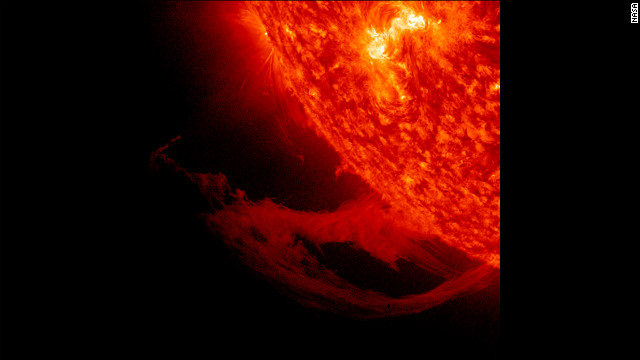 This close-up view of a prominence reveals magnetic forces at work as they pull plasma strands this way and that before it gradually breaks away from the sun over a one-day period November 14-15, 2011.
This close-up view of a prominence reveals magnetic forces at work as they pull plasma strands this way and that before it gradually breaks away from the sun over a one-day period November 14-15, 2011. 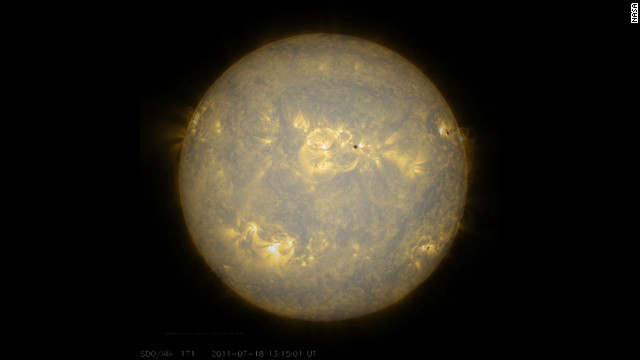 Sunspots, which are cooler, darker areas of intense magnetic activity, are most often the source of solar storms. If we take the observations of the sun's lower atmosphere in extreme ultraviolet light July 17-18, 2011.
Sunspots, which are cooler, darker areas of intense magnetic activity, are most often the source of solar storms. If we take the observations of the sun's lower atmosphere in extreme ultraviolet light July 17-18, 2011.
- Strong Geomagnetic Storm Watch issued
- Storm could impact power grid, satellites
- Auroras possible in northern latitudes
(CNN) -- This is not your usual weather forecast. Big storms are brewing. Your umbrella won't help, but you might want to keep a flashlight handy.
These storms are coming from the sun. It's raining down a huge amount of radiation. We're safe, but it could affect power grids, radios and satellites.
Experts say the combined energy from two recent solar events will arrive at Earth on September 13, prompting the Space Weather Prediction Center to issue a strong Geomagnetic Storm Watch.
Whaat kind of watch? Basically, the sun is a giant ball of gas -- 92.1% hydrogen and 7.8% helium. Every now and then it spits out a giant burst of radiation called a coronal mass ejection, or CME.
CMEs are sometimes associated with solar flares, the most explosive events in the solar system. The sun has released two CMEs in the past two days and both are linked to solar flares. NASA says the second flare is an X1.6 class, putting it in the most intense category.
The energy from those two CMEs is heading toward Earth.
Space weather experts aren't sure yet what this solar storm will do.
"This is a pretty strong solar storm and we just won't know until it gets here" what it will do, said CNN Meteorologist Chad Meyers.
Earth's atmosphere usually protects us humans, but you might want to keep a flashlight handy. Solar storms can knock out power, interfere with GPS and radio communications -- including those on commercial airliners -- and they can damage satellites.
On March 13, 1989, a solar storm knocked out power for the entire province of Quebec for 12 hours. Power grids in the U.S. were impacted, but didn't have blackouts. NASA says some satellites tumbled out of control for hours during what's known as the Quebec Blackout. The Space Shuttle Discovery was in orbit at the time and had a mysterious sensor problem that went away after the storm, NASA says.
On the upside, solar storms also create beautiful aurora. Aurora watchers in the northern U.S. should be watching the skies on Thursday and Friday nights.
Study: Massive solar storm barely missed us in 2012
No comments:
Post a Comment